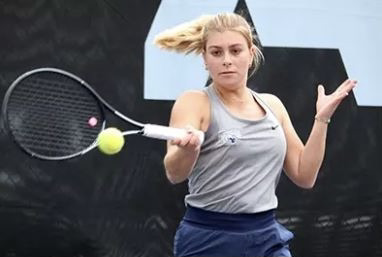Peppersack beats SM8 100 IM Paralympic record
4 min read
UMW Athletics
By GEMMA SPICKA-PROFFIT
Senior Writer
Sophomore Joey Peppersack was awarded CAC Men’s Swimmer of the Week after he broke the American Paralympic record for the SM8 100 meter Individual Medley during a home meet against Frostburg State on Oct. 26. Peppersack swam a 1:08.01, breaking the previous record by three seconds.
“We had a time trial here a couple Saturdays ago called the Blue and Gray meet. I swam the 100 IM, not expecting to do anything, and I think I ended up going a 1:09,” said Peppersack.
With the realization that he would be able to break the record if he raced for an official time, he got his coach’s approval and tried out the event.
“I got behind the blocks, got real pumped and had my teammates cheering me on. I dove in, swam as fast as I could and wasn’t sure what was going to happen. It was pretty cool; I wasn’t expecting to do anything this semester,” he said.
“I’m close to the 50 freestyle and the 100 freestyle [record, too]. I’m not sure if I’ll get those this year, but there’s always a chance,” he added.
Peppersack was born with a birth defect called tibial hemimelia.
“That is when you are born without a tibia, or the growth is severely affected,” said Peppersack. “I was born without a tibia in my right leg, and in my left leg, the growth was affected a lot. I had the one that was born without a tibia amputated when I was four.”
According to World Para Swimming, Paralympic athletes are “grouped by the degree of activity limitation resulting from an impairment.” Classes 1-10 are for physical impairments, where “a lower number indicates a more severe activity limitation than a higher number.” Classes 11-13 are for visual impairment, and class 14 is for intellectual impairment. An S before the class number indicates freestyle, butterfly and backstroke, SB indicates breaststroke, and SM indicates individual medley.
“I am an S8 for everything except for breaststroke, in which I’m an SB7,” stated Peppersack.
He stated that his condition does not affect his life much on a daily basis since he is used to it.
“When I want to do something, I just put my leg on, and when I’m relaxing, I take it off.”
“We’re very abled. We all have a disability, but that does not mean we’re disabled. I think that’s something a lot of people don’t understand, and we can do a lot more than people think we can do,” said Peppersack when asked about misconceptions about Paralympic athletes.
A big inspiration for Peppersack is his friend Robert Griswold, a teammate from the Para Swimming national team.
“He’s the same classification as I am for mobility, and he’s a machine. He’s super super quick, and I look up to him in everything that he does. I hope to get as close to him as I can one day,” said Peppersack.
When Peppersack was 17, he competed in the Paralympic trials for a chance to swim in the 2016 Paralympics in Rio. Although he placed top three in all of his events, he was not able to make the cut.
“I was pretty nervous, I wasn’t really going in expecting anything, I just wanted to have a really really good meet and see what I could do,” stated Peppersack. “It showed me what I could do, and what I couldn’t do.”
The experience he gained from the Rio Paralympic trials and from representing Team USA in the Para World Series in Berlin in 2017 will be utilized to help him prepare for the Tokyo Paralympic trials in 2020.
Leading up to the trials, Peppersack’s main goal will be “really trying to hit 100 backstroke because I think that’s my best chance in going. I’m communicating as much as I can with my current coach, Coach Anderson because he knows about the paralympics fairly well” since he’s coached several Paralympic swimmers in the past.
One challenge Peppersack faces when training for the Paralympics is that all of the Paralympic events are in meters, while all of the college races are in yards. Additionally, the Paralympic sized pools are long course, meaning they are 50 meters long. This is approximately twice as long as the college sized, short course pools, which are 25 yards long.
Peppersack prefers swimming in a yards pool because “long course is way too long.” However, swimming in a long course pool is also “kind of nice because there are less walls, and I kind of lack on walls because I don’t have another leg to push off with.”
In the end, it does not make too big of a difference where he trains, as long as he gets about a week to train in a long course pool leading up to meet that will use one.


